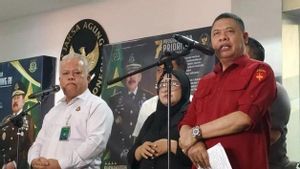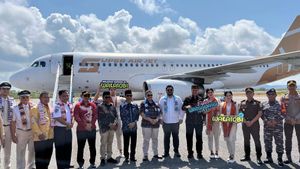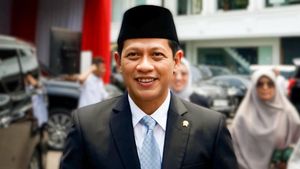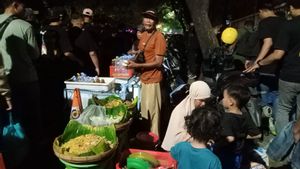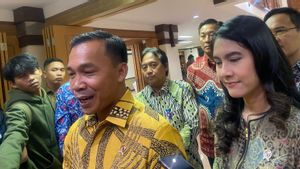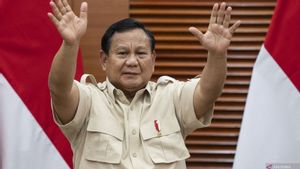JAKARTA - Minister of Creative Economy/Head of the Creative Economy Agency (Menekraf/KaBekraf) Teuku Riefky Harsya appreciated the role and contribution of the "Indonesian Weaving Image (CTI)" in strengthening the creative economy ecosystem of fashion sub-sectors, especially woven fabrics, through various programs that have been implemented for the last 16 years.
"We really appreciate the various programs that have been implemented by Cita Tenun Indonesia, and are very open to collaborating with CTI in supporting the strengthening of the national creative economy ecosystem," said Minister of Creative Economy Teuku Riefky Harsya during an audience with the management of "Chita Tenun Indonesia (CTI)", Friday (8/11/2024) at the Sapta Pesona Building, Jakarta.
President Prabowo Subianto's creative economy has been designated as "The New Engine of Growth" which is expected to make a significant contribution to national economic growth in the next five years.
Minister Teuku said that the determination of the creative economy as a new engine for national economic growth itself was based on various things. Starting from the juridical/technical, academic, empirical, and political foundation.
"Therefore, in the aspirations, the creative economy and the creative industry are mentioned more than 20 times. And this makes me confident that the President must have a great desire to develop the creative economy in the future. We believe that the direction of the asta is an effort to prepare the creative economy so that it can become a new engine of growth for the national economy," said Minister Teuku.
The Ministry of Creative Economy in the next five years is expected to contribute to increasing the ratio of the creative economy to the national GDP from 6.70 percent (in 2023) to 8.37 percent. Then the export value from 23.90 million US dollars (in 2023) to 29.88 million US dollars, the investment value of Rp183.72 trillion from Rp136.28 trillion (in 2023), and labor absorption reached 27.66 million people from 24.92 million people (in 2023).
Therefore, said Minister Teuku, the role and support of all stakeholders including CTI is very much needed by the government. The government, he said, could not work alone to answer various challenges in an effort to achieve the targets that had been set.
These challenges range from marketing and capital aspects, aspects of HKI and creative products, aspects of regulation and institutionalism, as well as aspects of technology and infrastructure.
"To accelerate the realization of this supporting infrastructure, the collaboration between the government and the private sector is a necessity. And CTI in the last 16 years has contributed a lot, starting from providing training, marketing, as well as preserving Indonesian weaving," said Teuku.
The management of Cita Tenun Indonesia, Aliya Rajasa Yudhoyono, explained that Cita Tenun Indonesia is an association of weaving cloth lovers who then have a vision to maintain, improve, preserve, and market the richness of Indonesian weaving.
SEE ALSO:
"For us, we weaving is the art of traditional Indonesian culture which has meaning and historical values as outlined in various motifs, colors, types, materials, and threads that reflect the identity of the nation. So indeed this woven fabric cannot be separated is not only typical or traditional but it is the identity of the nation, the identity of our nation," said Aliya.
For this reason, said Aliya, since 16 years ago Cita Tenun Indonesia has consistently run various programs. The first is preservation, namely based on data compiled by CTI 16 years ago, there are many rare weaving motifs that are almost extinct. This happened because the generation of weaving craftsmen in various regions in Indonesia had disappeared.
"At that time, many young people were reluctant to be WEaving, and the work on weaving motifs was quite difficult and also difficult to market it," said Aliya.
Seeing this, CTI seeks to intervene by going to the regions to conduct training and development of craftsmen so that they can return to producing weaving. Even CTI involves well-known Indonesian designers to conduct direct training in the field. Starting from design training, coloring experts, motif makers, and others.
"Until finally these weaving can collaborate with designers and make their weavings applied to various designer designs and provide added value," said Aliya.
Not only training and facilitation, but CTI also consistently fosters and brings works from weaving to be marketed abroad. He also hopes to expand collaboration with the Ministry of Creative Economy so that it can provide wider benefits for weaving craftsmen in the regions.
Until now, CTI through its programs has intervened more than 1,000 weaving craftsmen in various regions in Indonesia.
"We hope to contribute more to the success of government programs, so that the great goal of the creative economy's progress in Indonesia can continue to be achieved," said Aliya Rajasa.
The English, Chinese, Japanese, Arabic, and French versions are automatically generated by the AI. So there may still be inaccuracies in translating, please always see Indonesian as our main language. (system supported by DigitalSiber.id)






